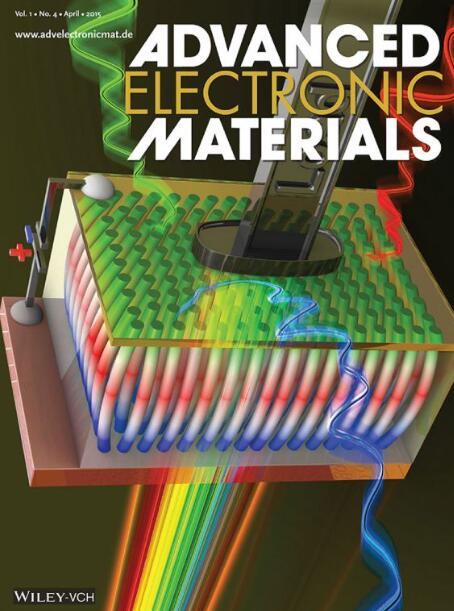Electrochemical Doping for Absorption and Conductivity Tuning of P(NDI2OD-T2) Films
IF 5.3
2区 材料科学
Q2 MATERIALS SCIENCE, MULTIDISCIPLINARY
引用次数: 0
Abstract
Electrochemical doping of thin films of poly{[N,N′-bis(2-octyldodecyl)-naphthalene-1,4,5,8-bis(dicarboximide)-2,6-diyl]-alt-5,5′-(2,2′-bithiophene)} (P(NDI2OD-T2)) is shown as straightforward method to achieve different degrees of doping both during in situ electrochemical experiments as well as in the solid state. Results obtained from cyclic voltammetry and absorption spectroscopy upon reduction can be explained by the presence of the neutral state as well as polaron and bipolaron species, including neutral/polaron and polaron/bipolaron mixed valence states. The UV-vis-NIR spectra are analyzed and explained based on the calculated electronic structure and the corresponding transitions between different states, this includes features such as numbers and positions of the peaks and their evolution during reduction. Most intruingly, doped films are stable after transfer in the solid state, as evidenced by absorption spectroscopy. Conductivity measurements of films with different degrees of doping show a bell-shaped conductivity profile, which underlines the classification of P(NDI2OD-T2) as a conjugated redox polymer with mixed valence transport. Maximum conductivities of up to 2 × 10−4 S cm−1 are obtained at intermediate doping levels under the coexistence of neutral state and polarons. Conductivity measurements of blade-coated films point to anisotropic charge transport with the highest charge transport along the blade /polymer chain direction and an anisotropic conductivity ratio of 4.1.

电化学掺杂用于P(NDI2OD-T2)薄膜的吸收和电导率调谐
电化学掺杂聚{[N,N ' -二(2-辛基十二烷基)-萘-1,4,5,8-二(二碳酰亚胺)-2,6-二基]-al -5,5 ' -(2,2 ' -二噻吩)}(P(NDI2OD-T2))薄膜是一种简便的方法,可以在原位电化学实验和固态中实现不同程度的掺杂。循环伏安法和吸收光谱在还原时得到的结果可以用中性态以及极化子和双极化子的存在来解释,包括中性/极化子和极化子/双极化子混合价态。根据计算得到的电子结构和不同状态之间的相应跃迁,包括峰的数量和位置以及它们在还原过程中的演变等特征,对紫外-可见-近红外光谱进行了分析和解释。最引人注目的是,通过吸收光谱可以证明,掺杂薄膜在固态转移后是稳定的。不同掺杂程度的薄膜电导率测量显示钟形电导率分布,这强调了P(NDI2OD-T2)作为混合价输运的共轭氧化还原聚合物的分类。在中性态和极化子共存的中等掺杂水平下,获得的最大电导率可达2 × 10−4 S cm−1。叶片涂覆膜的电导率测量表明,各向异性电荷传输,沿叶片/聚合物链方向的电荷传输最高,各向异性电导率比为4.1。
本文章由计算机程序翻译,如有差异,请以英文原文为准。
求助全文
约1分钟内获得全文
求助全文
来源期刊

Advanced Electronic Materials
NANOSCIENCE & NANOTECHNOLOGYMATERIALS SCIE-MATERIALS SCIENCE, MULTIDISCIPLINARY
CiteScore
11.00
自引率
3.20%
发文量
433
期刊介绍:
Advanced Electronic Materials is an interdisciplinary forum for peer-reviewed, high-quality, high-impact research in the fields of materials science, physics, and engineering of electronic and magnetic materials. It includes research on physics and physical properties of electronic and magnetic materials, spintronics, electronics, device physics and engineering, micro- and nano-electromechanical systems, and organic electronics, in addition to fundamental research.
 求助内容:
求助内容: 应助结果提醒方式:
应助结果提醒方式:


